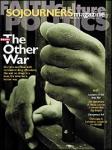A recent University of Maryland study found that African Americans who kill whites are much more likely to get the death penalty than others convicted of the same crime. Nationwide, a black teenager convicted of a drug crime is 48 times more likely to be sentenced to prison than a white one.
It's not news that race matters in our criminal justice system. What doesn't get enough attention, and should, is that for the last two decades the "war on drugs" has helped make racial disparities in our penal system get much worse very quickly. In 1950, a black person was four times as likely as a white one to be in prison; today, that has worsened to more than seven times. Four out of five state drug prisoners are African American or Latino, although these groups comprise only 22 percent of drug users (and 25 percent of the U.S. population). And these disparities permeate every level of the criminal justice system, from policing to parole (see "Equal Justice?" p.24).
Systemic and individual racism are part of the story here, but they can't explain why prison race ratios have gotten so much worse since 1950, even as many parts of our society have shown improvement. In order to understand why our system is not colorblind, we're going to have to learn to see the color green.
Consider this thought experiment: Imagine if the United States allowed, and even encouraged, public servants to take bribes in exchange for preferential treatment in arrests, charges filed, and plea bargains. Since there is a big wealth gap between whites and minorities in this country—the typical African-American household owned about 8 percent of what a white one did at the end of the 1990s, and black unemployment is double the rate for whites—we wouldn't be surprised to see racial disparities show up in arrests, charges, and convictions.
Of course, we don't live in a system where bribery is common; we just live in an eerie simulation of one. Once a society commits to the numbers game of mass arrests and long incarcerations for petty drug crimes, money is going to play a key role in criminal justice disparities. This is true even when individual officials are acting with the best of intentions. Want to put away as many drug dealers as possible on a limited vice squad budget? Better target dealers in poor neighborhoods, where drug activity happens more on the street and less behind closed doors. You may be motivated entirely by a laudable desire to cut back on the disproportionately high rates of violent crime that these communities suffer, but you'll still wind up arresting many people who only come to police attention because their families can't afford to send them to private drug treatment programs. Need to make the best of your understaffed district attorney's office? It's only pragmatic to cut a plea bargain with that rich guy's lawyers, and take a harder line with the overworked public defender.
We sometimes hear protests, as well we should, about how indigent defendants facing the death penalty are saddled with ludicrously underpaid and underqualified lawyers. But money makes a crucial difference in lower-profile, nonviolent cases too, and it does so by the hundreds of thousands. State courts sentence 71 percent of indigent convicted persons to prison, but only 54 percent of those who can hire their own lawyers. Wealth is the missing link in American penal racism (as it often is in American politics, where any concern for the poor is routinely dismissed as "class warfare").
The good news here is that we don't have to wait for every judge, prosecutor, and cop in America to be free of individual racism (we might be waiting a while). The bad news is that we have to take responsibility for the ways in which our system is sinfully prejudiced against those with low incomes.
To fix this situation, we'll need money and political will. Fortunately, we've already shown that we're willing to spend money—for what we're spending on each prisoner each year, we could put three people through an intensive 20-week inpatient treatment program. To get the political will, though, we must be willing to admit that we have a problem. We'll also need to admit that when politicians spent the last two decades shopping for a "tough on crime" image, they inevitably left the poor—disproportionately people of color—to pay the price.
Elizabeth Palmberg is assistant editor at Sojourners.

Got something to say about what you're reading? We value your feedback!